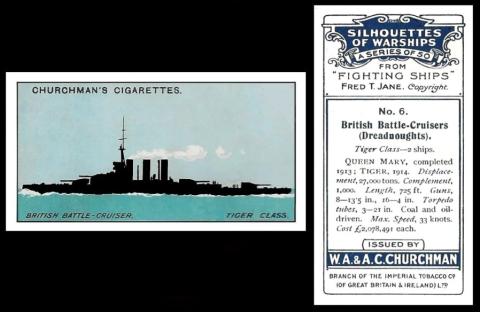
Here we have a British Battle-Cruiser of the Tiger Class, which contained just two ships, HMS Queen Mary, built in 1911, and HMS Tiger, built in 1910. Both these are mentioned on the reverse of this card, but we know that they were different sizes, none of which seem to fit with those on the card - HMS Queen Mary being 698 ft long at the waterline and just over 703 ft overall, with a displacement of between 26,780 and 31,486 tons - and HMS Tiger being almost 698 ft at the waterline and 704 feet overall, with a displacement of between 28,800 and 33,677 tons. Both had eight guns. Neither had three torpedo tubes, HMS Tiger having four and HMS Queen Mary only having two. However, in the archives of Palmers Shipbuilding and Iron Company in Jarrow, the makers of HMS Queen Mary, it is stated that she cost cost £2,078,491 to build, including the guns, the exact figure quoted on this card - whilst those of the John Brown and Company shipyard in Clydebank, the makers of HMS Tiger, quote the cost at £2,593,100.
It seems likely therefore, that this silhouette is of HMS Queen Mary. She was started in 1911 and completed in 1913, and her first battle was at Heligoland in 1914, she then went to Jutland in 1916, where she was hit and destroyed by the German battleship Derflinger, with the loss of 1,266 officers and men. Only twenty men survived, who you can read more about at Jutland Crew Lists
HMS Tiger was the most armed of all the Battle-Cruisers at the start of the First World War, which is almost certainly why she cost more to build, but she was late to join in, only turning up in time for the Battle of Dogger Bank on the 24th of January 1915, possibly only six days before this set was issued. She also fought at Jutland, with her sister, and the second of the battles of Heligoland in 1917, but from the end of 1917 she was sent to patrol the North Sea. After the First World War she served as a gunnery training ship, but had a brief return to glory as a substitute for HMS Hood during its refit at the start of the 1930s, However after that her days were numbered, and she was sold, for scrap, in 1932.
Oddly there was another Tiger class of Battle-Cruisers, the Blake, the Lion, and the Tiger, which were commissioned during the Second World War but did not see service until the end of the 1950s.
This set first appears in our original Churchman reference book, RB.10, published in 1948, where it is listed as :
129. Feb.1915. SILHOUETTES OF WARSHIPS (titled series). Size 2 11/16" x 1 7/16", or 67 x 36 m/m. Numbered 1-50. Silhouettes from "Jane`s Fighting Ships". Fronts printed by letterpress (line blocks) in light blue, sea blue, and black. Backs in blue, with descriptions. Printed by Mardon, Son & Hall. Errors : cards 24 and 37 exist with backs transposed and inverted.
Actually what the card says is "Silhouettes of Warships, a series of 50, from "Fighting Ships". Fred T. Jane. Copyright". "Fighting Ships" was a book, better known as "All The World`s Fighting Ships", or as "Jane`s Fighting Ships". It also had a second volume. "All The World`s Airships", and both were written by John Fredrick Thomas Jane, born on the 6th of August 1865, in genteel Richmond, Surrey.
His father, perhaps oddly, was a vicar, and I say oddly because his son was into things like warships, and toy soldiers, and writing science fiction stories, two of which were published to quite good reviews in the late 1890s.
It was about that time too that he started to collect together all his childhood drawings of warships, with a view to publishing them in a book, which could be kept on board a ship in order to identify friend or foe. He soon realised that it would be better to draw them as silhouettes, the way that they would present themselves on the horizon, rather than taking hours to render the surface of each ship in great detail. The first edition was published in 1898, as "All The World`s Fighting Ships", though it soon became known colloquially as "Jane`s Fighting Ships".
His greatest desire was that it became the standard guide for ship identification, and maybe even be on the list of books that were supplied to Naval shipping. This never really happened, and though the books were often used by the Navy it was always in a very unofficial capacity, self funded by the officers themselves. The main reason for this was that the author was very political, standing as an Independent Candidate in the Portsmouth seat in the 1906 General Election, and frequently disrupting any appearances of the Liberal Party, which he detested.
Sadly he died in March 1916, of influenza, which affected his already weakened heart. By that time he had remarried, though he stressed, rather uncomfortably, that his body was to be buried with his first wife.
Returning to those errors, the ships concerned are the Russian Battleship "Slava (on card 24) and German Dreadnoughts, "Kaiser" Class (on card 37). I have not been able to find these cards, so I cannot say whether they are always the wrong back and printed upside down, or whether sometimes the wrong back is the right way up, making it harder to spot.
By the time of our original World Tobacco Issues Index, this set was simply listed as :
SILHOUETTES OF WARSHIPS. Sm. Nd. 50. ... C82-28
The updated version of this book has the same entry but a new code, of C504-360
